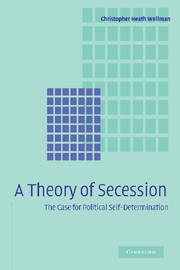Book contents
3 - Valuing Self-Determination
Published online by Cambridge University Press: 18 July 2009
Summary
The samaritan theory of political legitimacy outlined in the preceding chapter illustrates that territorial states are necessary, but it is important to recognize that there is nothing about the necessity of political society that requires us to retain our current states in their existing configurations. There is no reason, for instance, why a statist cannot consistently recommend that territorial borders be redesigned so that states are made more stable, more efficient, more in keeping with historically legitimate claims to land, or perhaps more aligned with the ethno-cultural characteristics of their constituents. A theorist concerned with stability might suggest that states take whatever shape is least likely to change over time; someone interested in efficiency might reshape states so that they are best suited to perform their requisite functions; those concerned with historical claims to territory might seek to redraw political boundaries in an attempt to undo the history of unjust annexations, dubious treaties, and ethnic cleansing; and an advocate of nation-states could recommend tracing political borders along the lines of ethnic and cultural distinctions. While all four of these alternatives are consistent with statism, I advocate a fifth option that is more in line with that recommended by authors such as Harry Beran, David Copp, David Gauthier, and Daniel Philpott: Citizens ought to be allowed to redraw political boundaries in any way that is politically feasible.
- Type
- Chapter
- Information
- A Theory of Secession , pp. 34 - 64Publisher: Cambridge University PressPrint publication year: 2005



